A bit of waiting time for you, dearest reader, since my last article had been published. I´m back now from the shakedown cruise with the awesome Oceanis Yacht 60 from Les Sables d´Olonne to Porto and here´s the second and final part of my little documentation about a bog boat´s handover process. You may have read the first part about the three day training our buyers and fresh owners receive when taking over their yachts, now, let me show you how the story went on aboard SOSIMA and her sympathetic fine family crew.
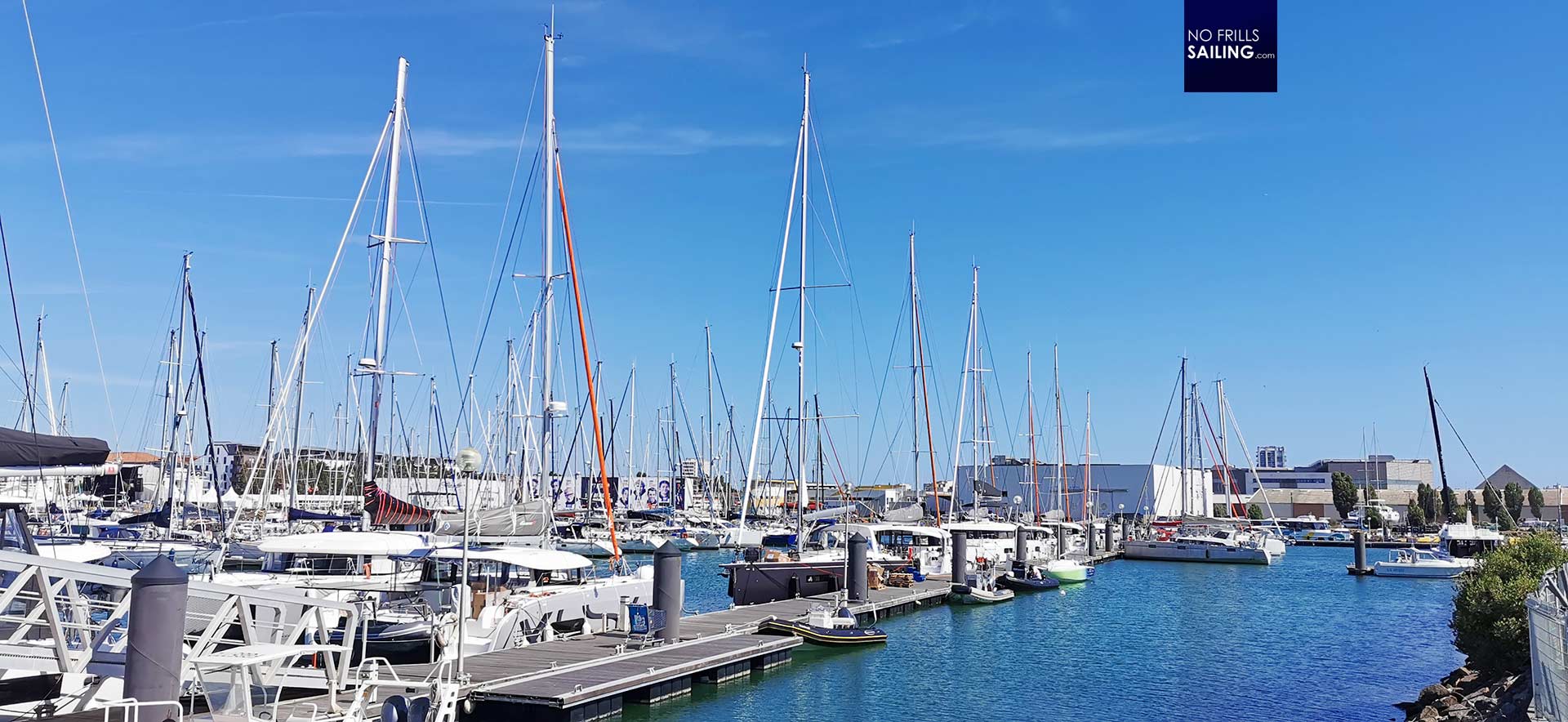
Here in Les Sables d´Olonne at the “Beneteau Pontoon”, as I call it, we are greeted with mild sunny weather and nice temperatures. Looking at all the monohulls and Catamarans, it may give you a scale of the size of this operation. The guys commissioning and preparing the new boats here for the owners are doing a fantastic job: One boat after the other arrives from the shipyard, receives its bottom paint, is rigged and equipped, readied and finished to be taken over by their new owners. A professional service, precisely timed and constantly re-scheduled to quickly adapt to changing weather conditions, late deliveries or other things happening frequently. It´s amazing how they always keep most of the deadlines and retain their friendly, open and funny attitude. A job that needs to be acknowledged and appreciated much, much more in my opinion.
Training and recap
Back aboard SOSIMA, third and last day of the 3-day Premium handover. Together with me, the very dealer, there are two guys from Beneteau Premium Service who are available the whole three days, explaining, showing and training. It´s a special service that can be booked by our clients upon request. For a boat the size and complexity as this Oceanis Yacht 60 I always recommend to invest in the Premium Service – as good as I may go through all the technical details of the yachts myself, for these yachts it´s best to have the shipyard with you for sure.
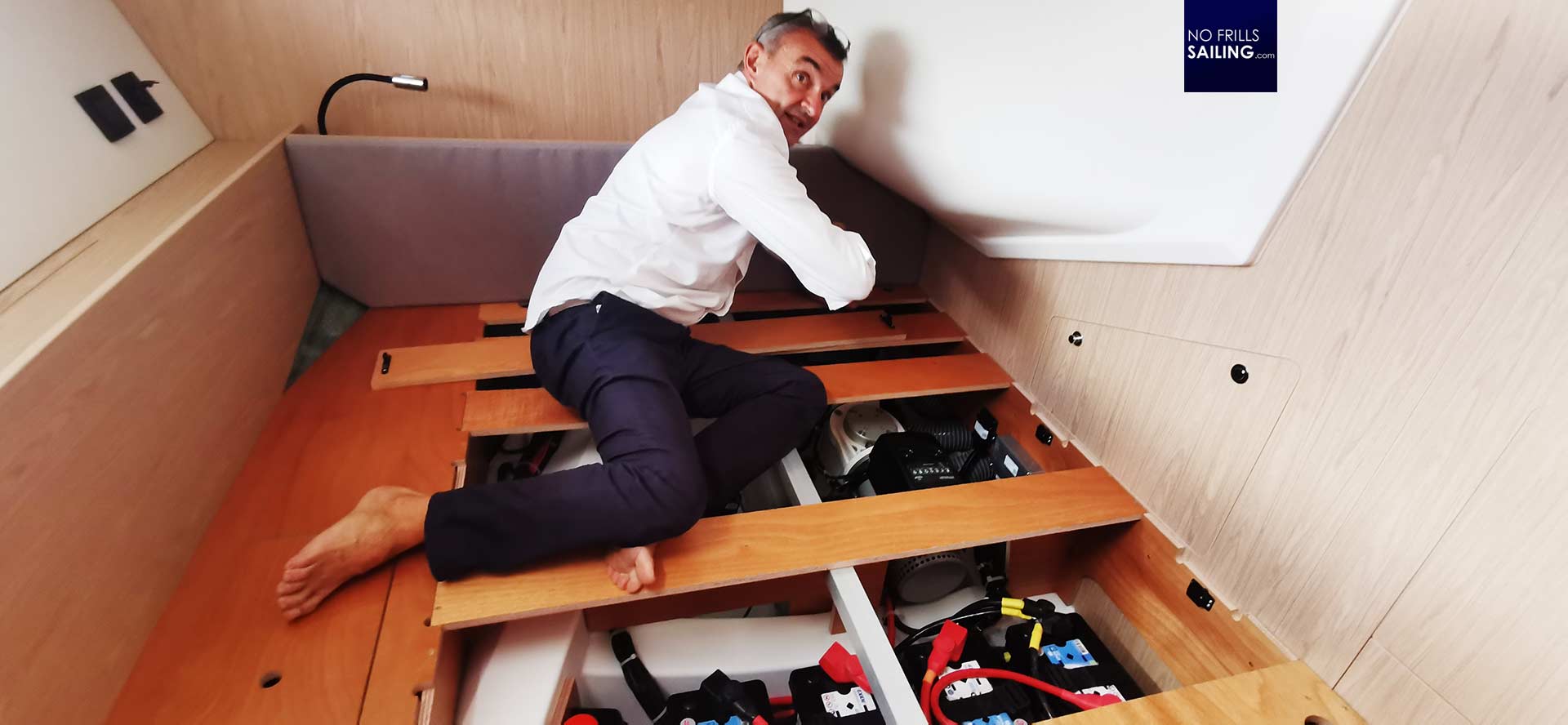
The prior two days had been packed and stuffed with all details of the flagship. We basically went from bow cabin to stern cabin down below and also on deck. A special emphasis of our training, no matter if you booked the shipyard´s Premium Service or our boat dealer handover, is on the safe operation of the new boat. Being a sailor myself it´s of my utmost concern that our new fresh owners are capable of operating their yacht in a safe manner.
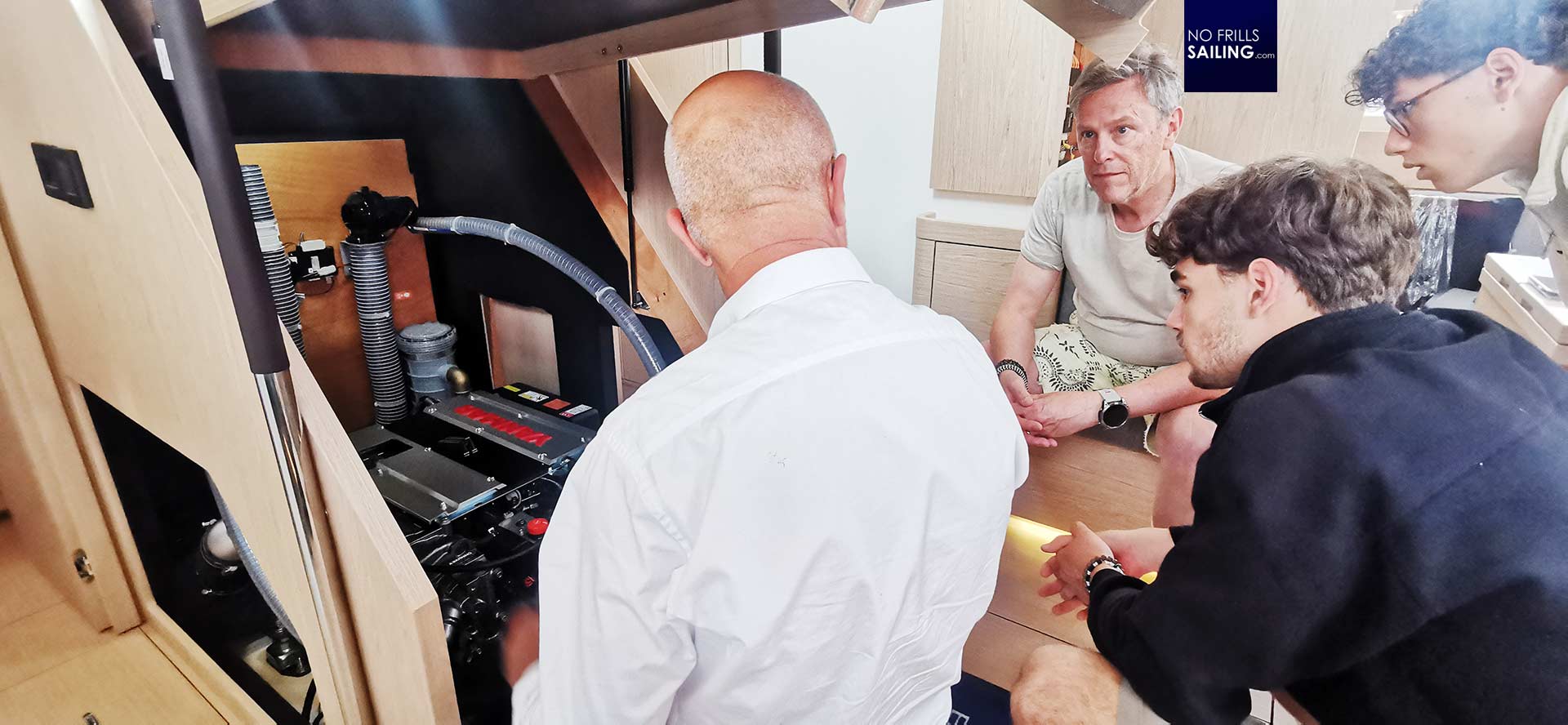
In this, the main focus is on how to make sure that nothing breaks or fails. And also: Making sure that if something happens, feels not right, makes strange sounds or is about to fail our crew know the strategies to encircle the probable causes and have strategies at hand to locate and identify the failure. A large portion of time is invested in introducing our crew to the big Diesel engine and its auxiliary devices. The worst thing that can happen is a rudderless ship that has lost engine power. In our case, a mighty 150 horse power Yanmar Diesel engine is fitted. We explain in detail where things are, how a smooth running is guaranteed and which parts need frequent checking and maintenance.
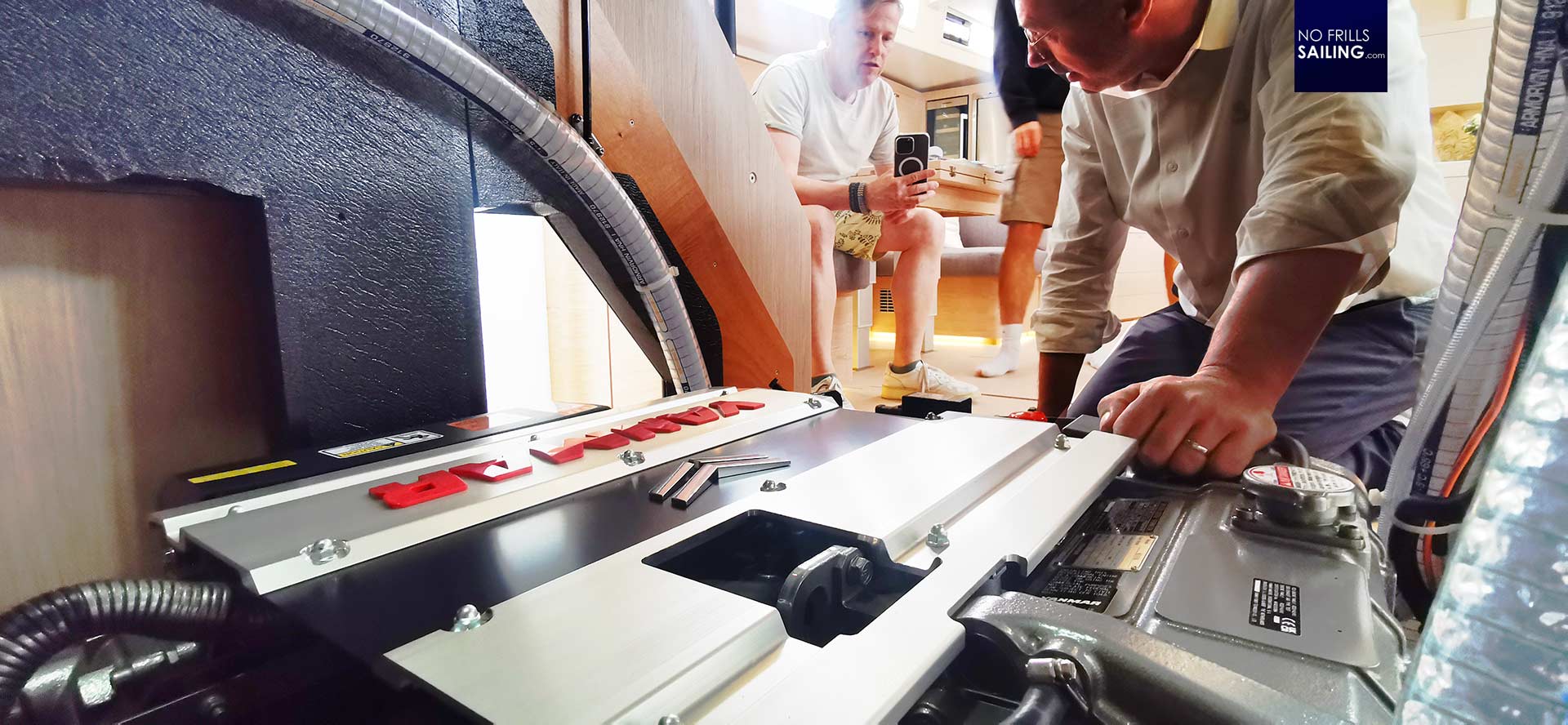
For the Oceanis Yacht 60 however something special is fitted in this boat as well. As I always say, even as a boating pro myself, you never stop learning. In this case, Beneteau has fitted an automatic decoupling device to the drivetrain of the yacht. It means that, despite a folding prop is mounted, every time the engine is stopped for sailing mode, a hydraulic system will decouple the prop-shaft from the engine-shaft to have complete physical separation. A detail that will become important in a few days time …
More luxury means more responsibility
For me personally, sailing is about inward looking. It´s about the return to a simpler way of life that is more connected and maybe perhaps a bit more dependent to and on nature. Of course, sailing is also something deeply luxurious. And I don´t necessarily mean luxury as a matter of how big your boat is. Even the smallest boat is pure luxury for me. On this flagship, a big 60-footer, of course, luxury is on a different level. But during our training session we are taught a valuable lesson too: More luxury also means more work, more responsibility and more liability.
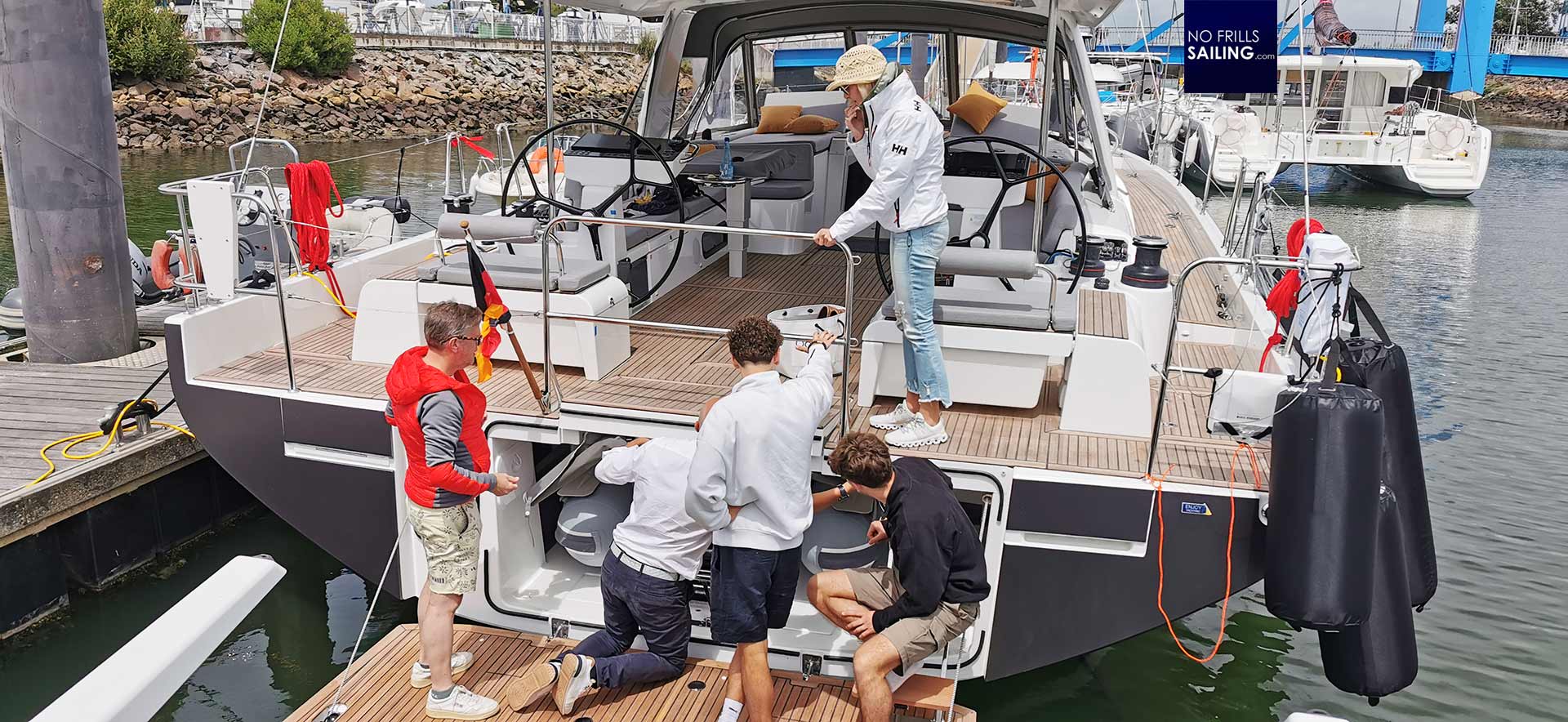
Take the dinghy garage for example. Starting with a boat size of around 55 feet I´d say that a dinghy garage inside a yacht´s stern makes sense. Below that size, from my point of view, the garages are too small, the size of the dinghy that fits is too small either – not mentioning the loss of aft cabin size inside. Now, about the dinghy garage on the Oceanis Yacht 60: It´s a real gem. A big-ass boat fits and, if ordered, the devices to launch it into the sea and get it back inside the garage make life so much easier. Nevertheless, it takes nearly an hour to explain and train.
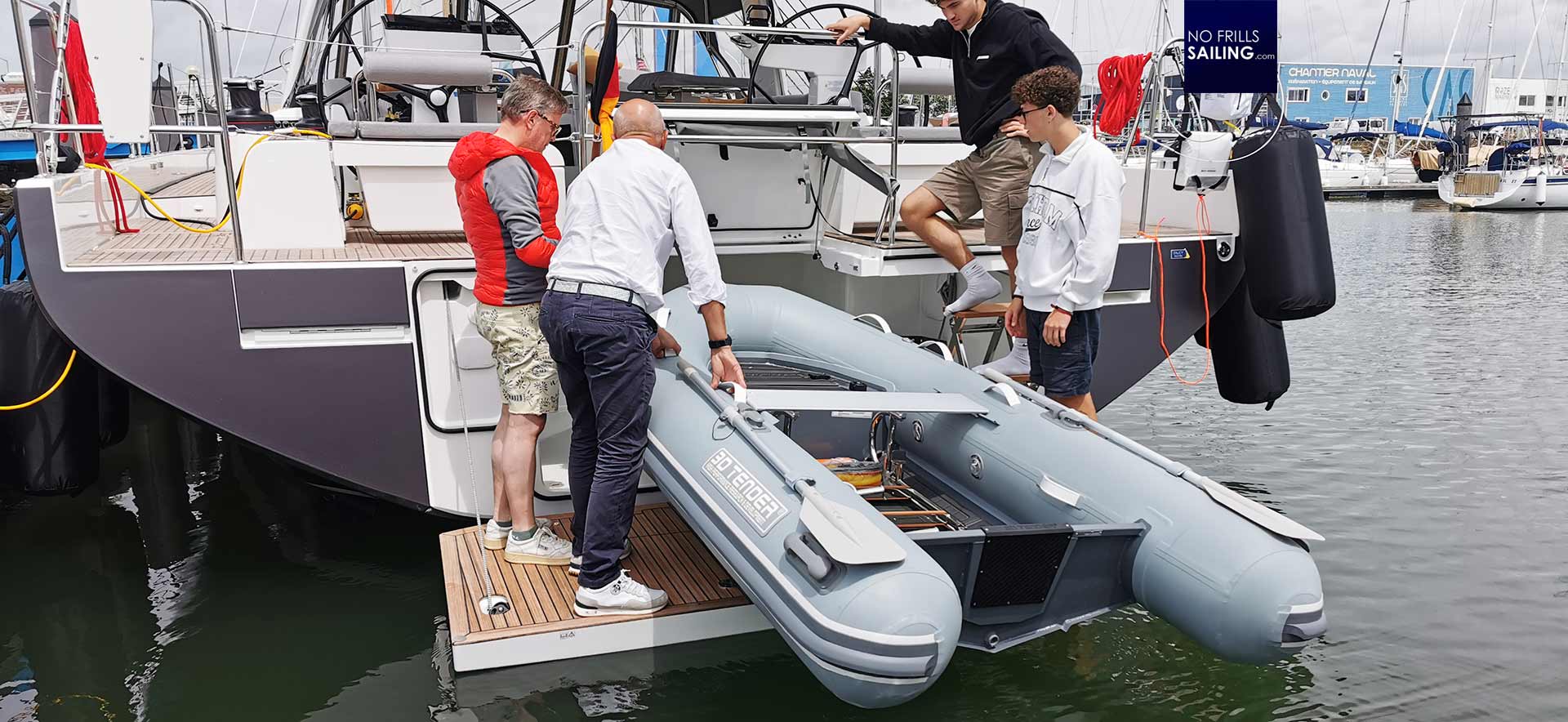
Maybe that´s the Gordian knot of sailing luxury (or luxury as a whole): The more you have of it, the more complicated it gets, the more attention you need to operate it and maintenance efforts to keep it running. Of course, it´s a no-brainer to use when trained, but inside my head – and I assume also in the respective heads of the owner family – the realization kicks in that luxury is a nonlinear equation, increasingly scaling up involvement of crew, maintenance efforts and of course, cost. Another interesting aspect of nowadays new boats is the digitalization.
Digital transformation in boating
I´ve written about it many times in this magazine. We are almost all car drivers and are more or less used to connected vehicles. My car “tells” me (and my dealership) what it wants, when things will need attention and so forth. Something that is the single biggest trend in boating as well: Getting the connected boat up to a level comparable to that of modern cars. It´s a huge undertaking. I know that Groupe Beneteau – after all the biggest leisure boat manufacturer in the world – is investing ridiculous sums to bolster their Seanapps-system that is exactly this, a boat fitted with sensors, telemetric data, wired and embedded in a global network.
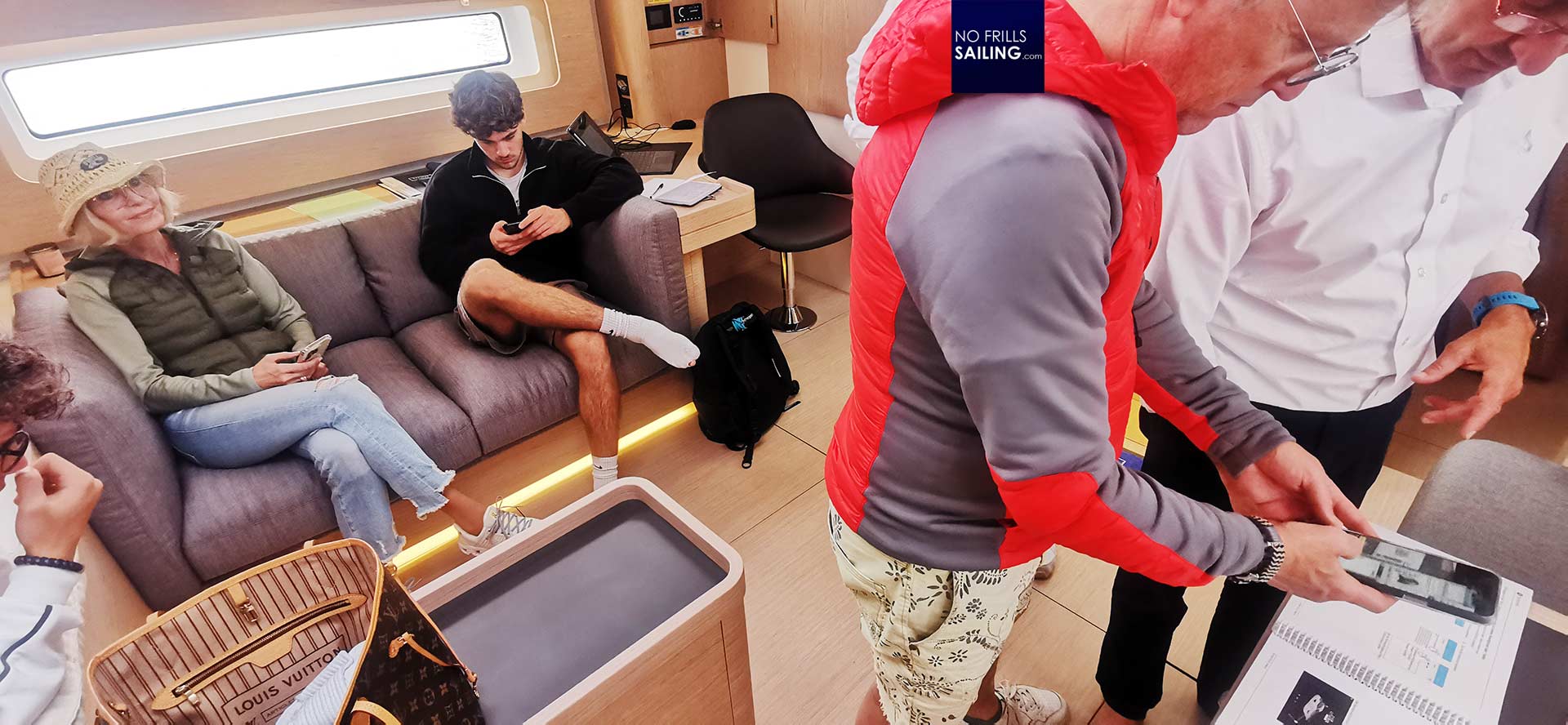
In this, our owners aren´t “just” sailors anymore – they are trained to become the system administrators of their digitalized yachts. Something that I see with some mixed emotions. On the one hand I really appreciate the convenience and safety of my BMW being so much connected. On the other hand: Didn´t we buy a boat to disconnect and literally sail away, leaving behind the fully digitalized world that is “always online”?! I am sure that this development cannot and will not be stopped. Right now we are in a transition phase – making a boat fully connected isn´t so “easy” as it is with cars. For example: Uniting all zeroes and ones that are emitted from those dozens of different components aboard made by dozens of different manufacturers is a Sysiphusian struggle indeed. That means that for now, apart from Beneteau´s Seanapps, our owners have to install half a dozen of apps – install, register, be trained to use and learn.
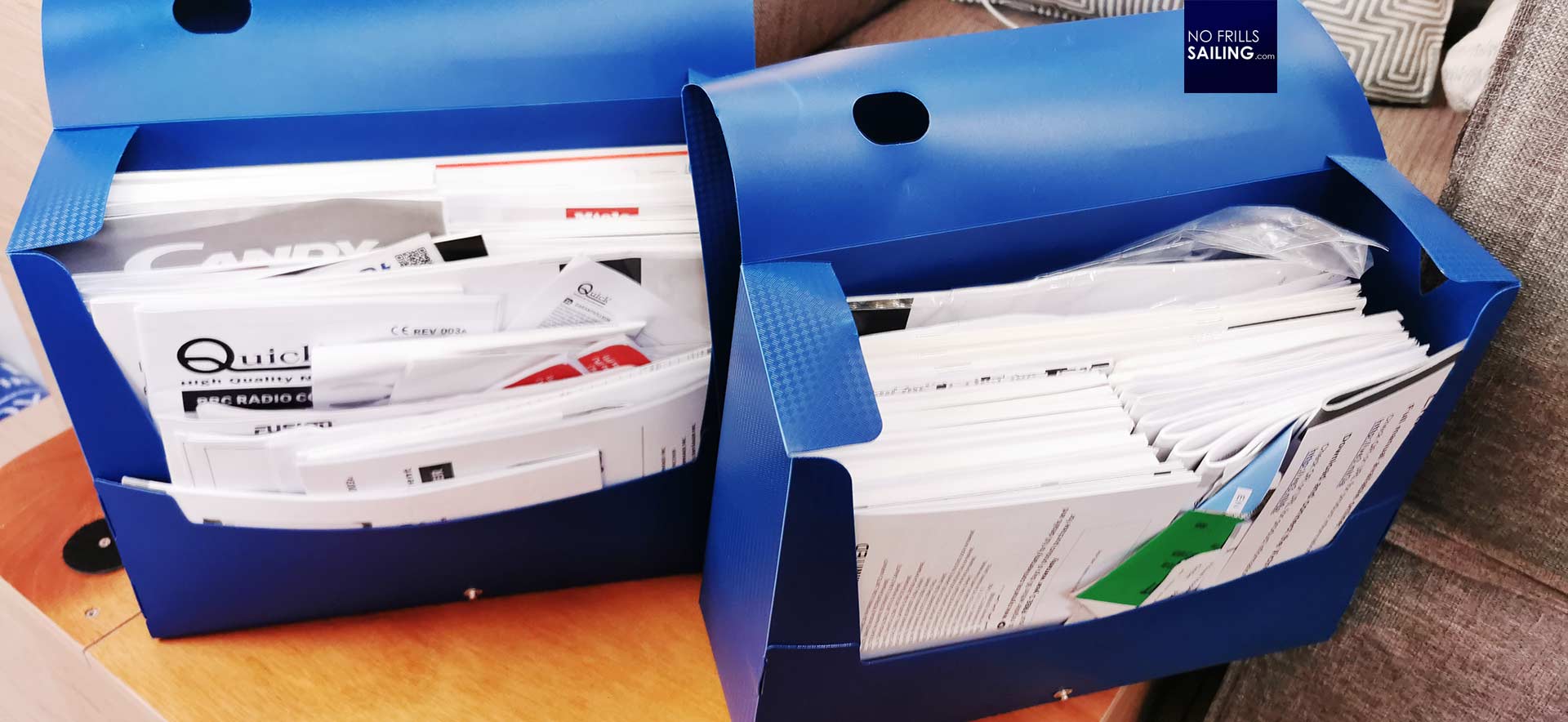
Whilst there is still lots of work for the developers to get the “all in one”-app for the boat, our owners end up being literally system administrators for their yachts. And it´s even more ridiculous: Apart from the multitude of digital services, I have to hand over two fully stacked thick volumes of literally a hundred (or more) printed owner´s manuals. Of course, I have to point out that the owner is obliged to read and study those (make of it what you want). Seeing this, it makes sense to bundle it all up in one master-app, or, which is the case in my own new boat, to install the minimum possible equipment with least possible digital output. Exciting times ahead, I´m sure. After a full forenoon packed with training and recap of the things we´ve done the past two days, we have a nice French lunch – and finally do what this boat is made to do in the first place: Sail!
Acceptance run!
After the minimal safety equipment is brought aboard, a proper flag is installed and all is done, we cast off the lines. Part of the normal handover process is always an acceptance run which involves testing the whole boat in seaborn conditions. Meaning, testing all engine-related functions, the auxiliary machinery, like generator, water maker, AC-unit and of course the steering-system, rudders, standing and running rigging. And the sails. A special occasion and truly the highlight in any handover. Our owner – a bit shaking but safe and steadily – casts off himself. A proud moment for SOSIMA, a big time moment for the family.
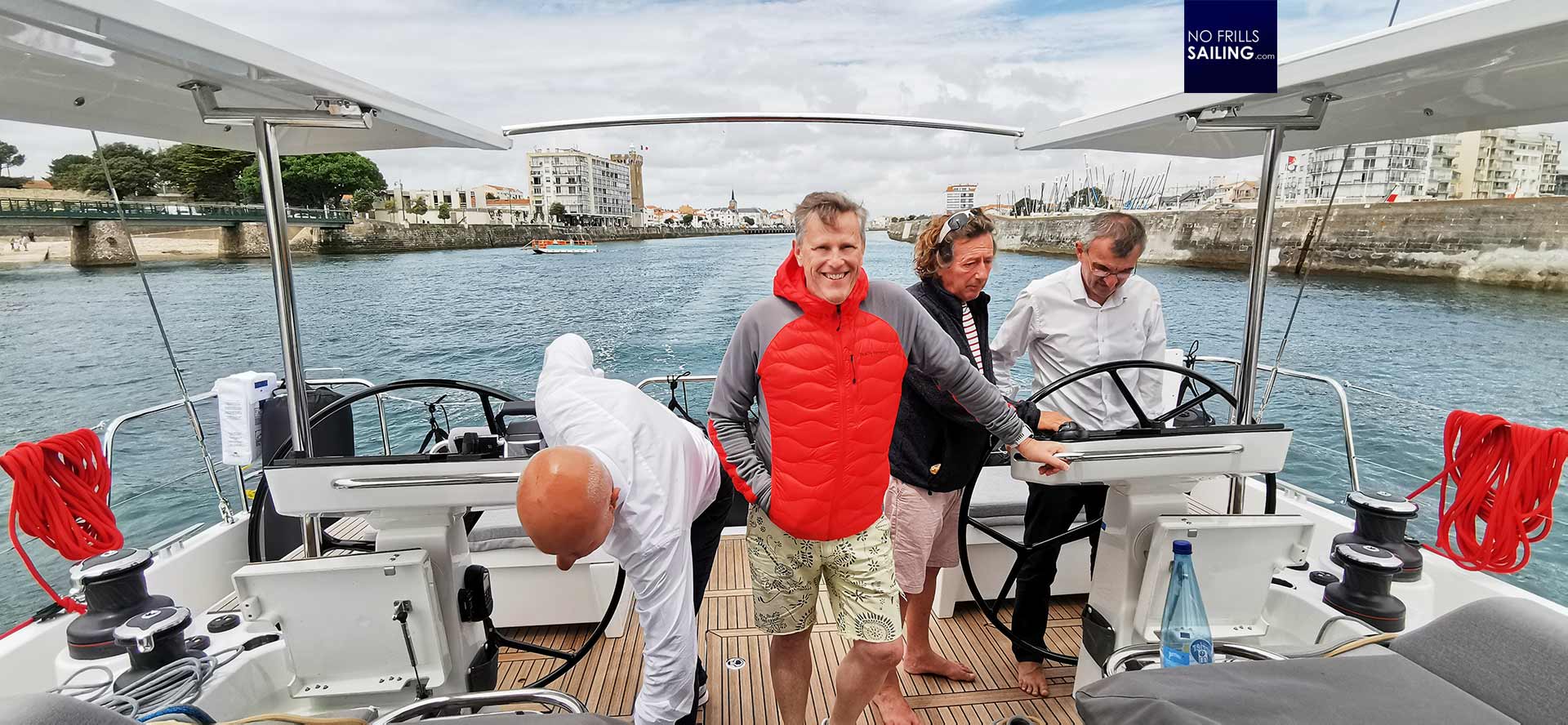
Outside Les Sables weather conditions are just as fine. As this yacht is equipped with in-mast furling and a full set of electric winches, “push button sailing” is not just a marketing gag but reality: It literally takes just two fingers to bring her full canvas to the wind, no physical work, no grinding needed. And then we cut off the engine – she takes up her booty and dashes out. What a great moment this always is! Bright smiles everywhere.
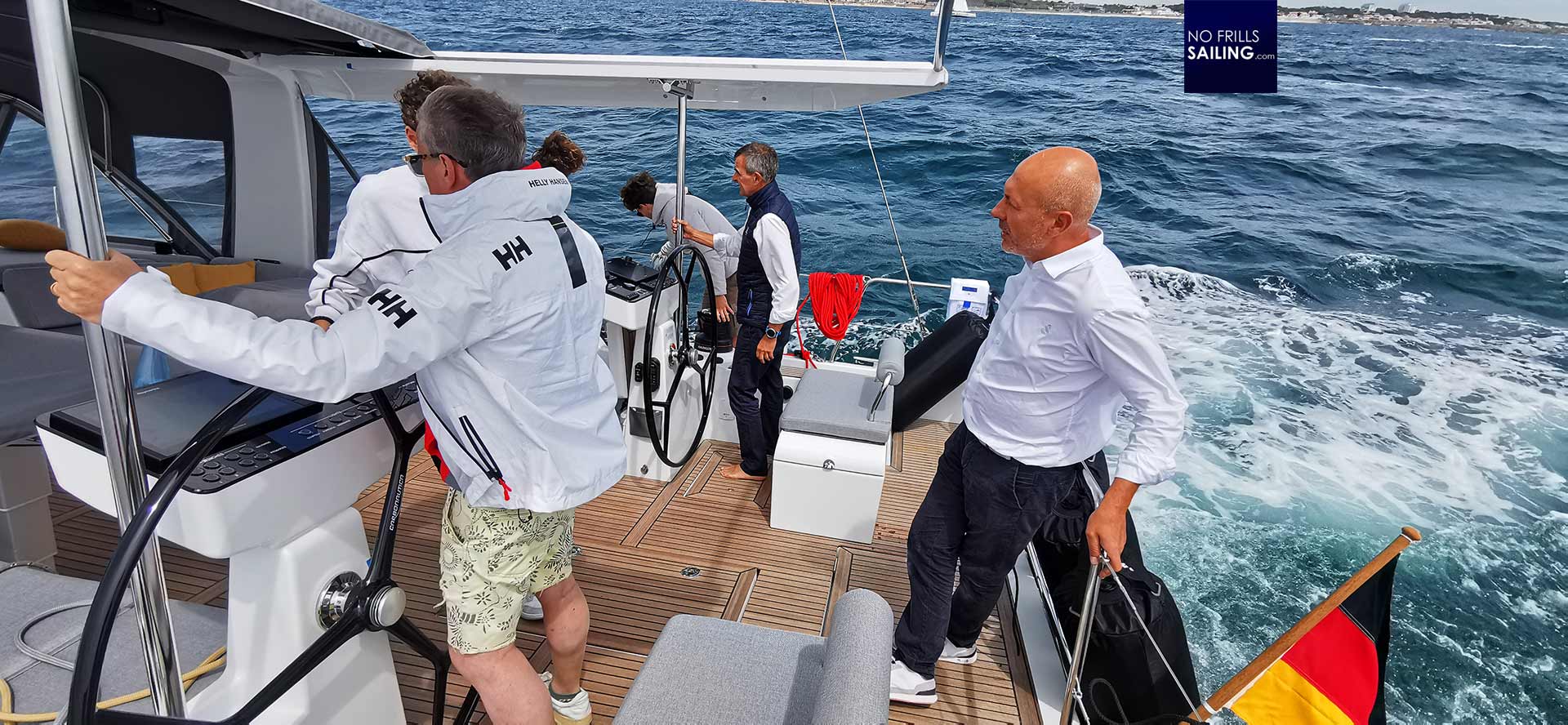
As the wind blows steadily with some 14 to 17 knots from ashore, we barely have waves. The boat´s log clocks an upwind speed of 8.5 to 10 knots, a re-assurance of my impressions from the past sea trials and many feedback from other dealers that this new flagship is not only a luxurious highlight but a true, keen sailboat with considerable sailing performance – something we will bring to the test much more later.
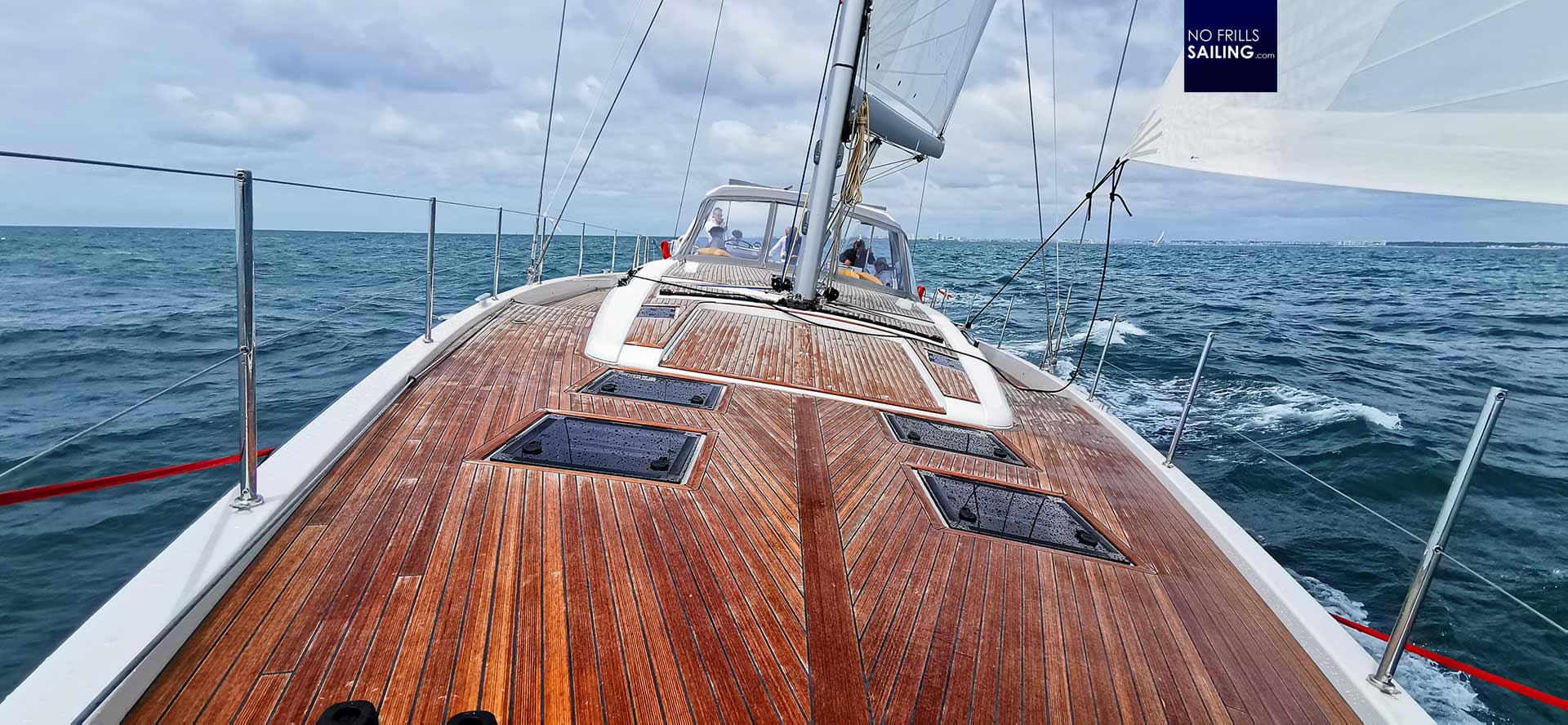
As for now, our owner family takes over the helm. Because there is some work to do here. The master rigger responsible for commissioning the boat, asks for a high upwind point of sail close hauled so that maximum load is on the shrouds and stays. Whilst we keep the boat stable with maximum heeling, he inspects the tension of each cable, terminals and parts of the standing rigging. This procedure is part of the acceptance run. We proceed with maneuvers, gybes and tacks, reefing and trimming of the sails. It´s fun as hell – but also a considerable program to run through.
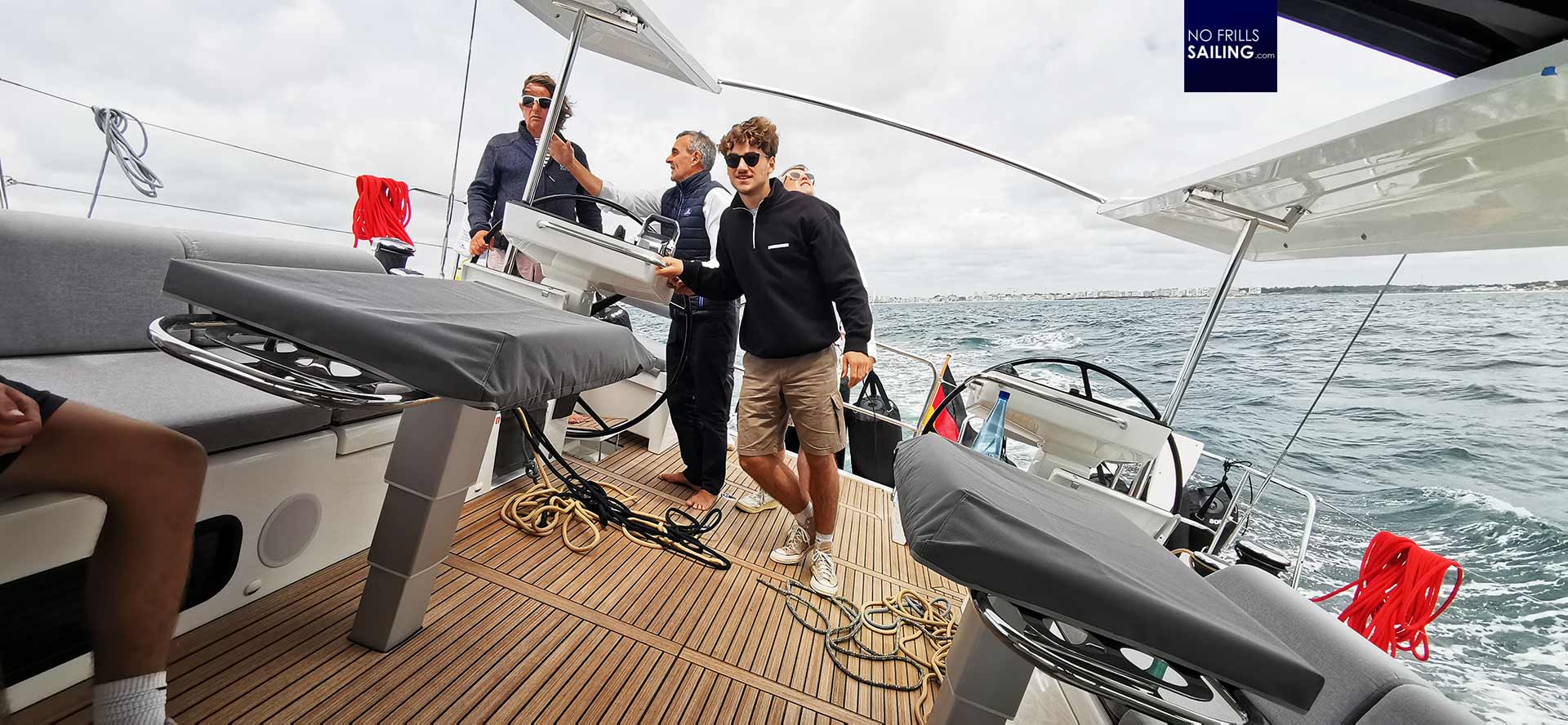
After almost two hours outside, all boxes have been ticked. This included also sharp turns, engine runs at flank speed, stopping and such. Whilst lying to, fully stopped, we test the water maker (now outside the raw water is much cleaner than the harbor-stuff) and also check all valves and seacocks for possible leaks or defects. It´s a strange and beautiful occasion: Still work, but also part fun. A harbinger of what is coming.
Pontoon mess …
After the acceptance report and many more documents had been signed by the owner, it is part to say Goodbye. At least for the guys from Beneteau: We truly thank them for being so involved, committed and dedicated during the past three intense days. Also, some last works are carried out by the commissioning service guys who do a marvelous job here. What starts now is the usual chaotic but beautiful process of outfitting the boat, making her ready to leave for the transfer cruise. In case of SOSIMA, it´s the Spanish Mediterranean coast. Quite a ride.
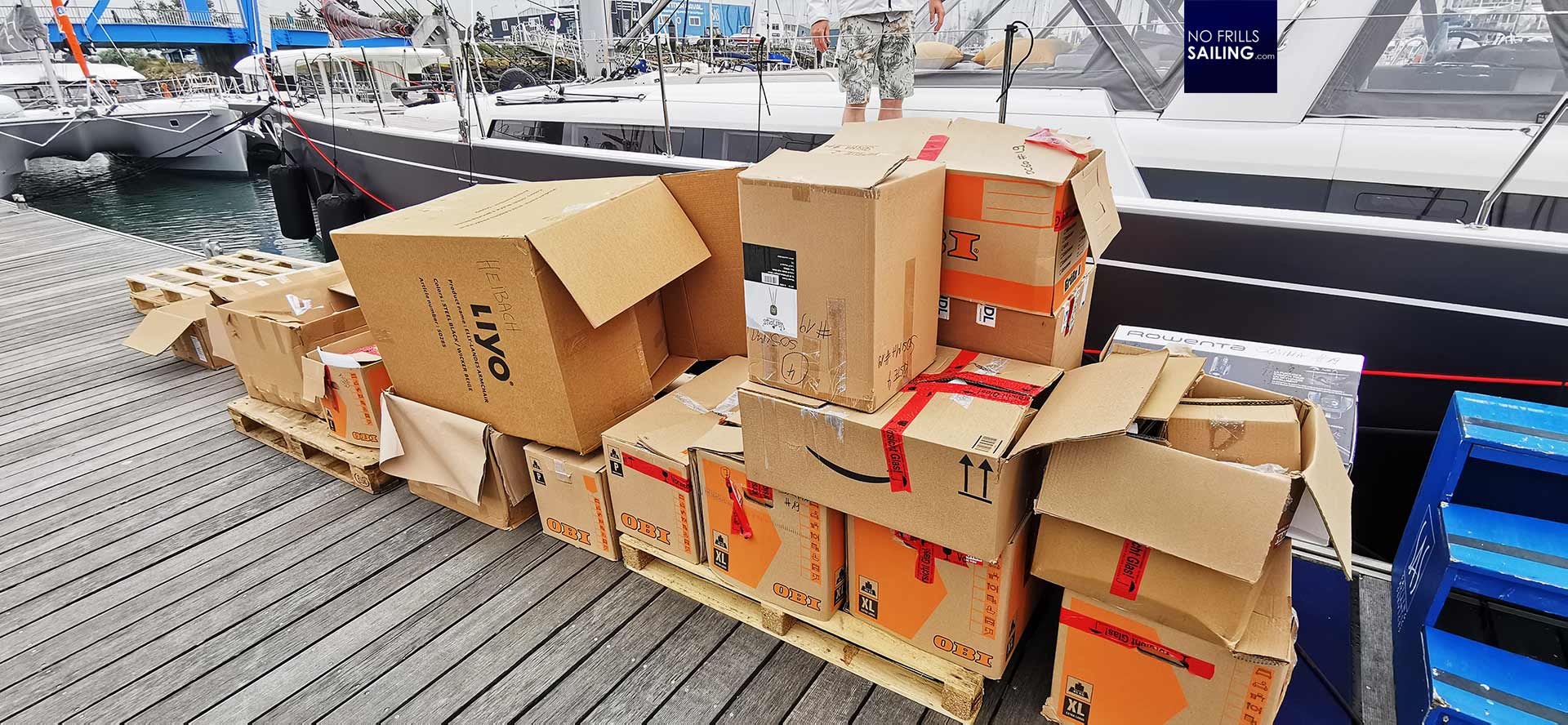
A few minutes later a mountain of cardboard boxes are arriving alongside on the pontoon. It always amazes me how much stuff a boat needs to be taken on to be considered fit to leave. It´s everything: From bed linen to cutlery, from nautical charts to distress signals, from oilskin bad weather gear to dinghy engine and much, much more. It´s a literal nightmare, a mess – being an owner myself I know what follows. So I say Goodbye for the time being, retreat to my rented flat nearby to do some office stuff, leaving the family alone to sort their things.
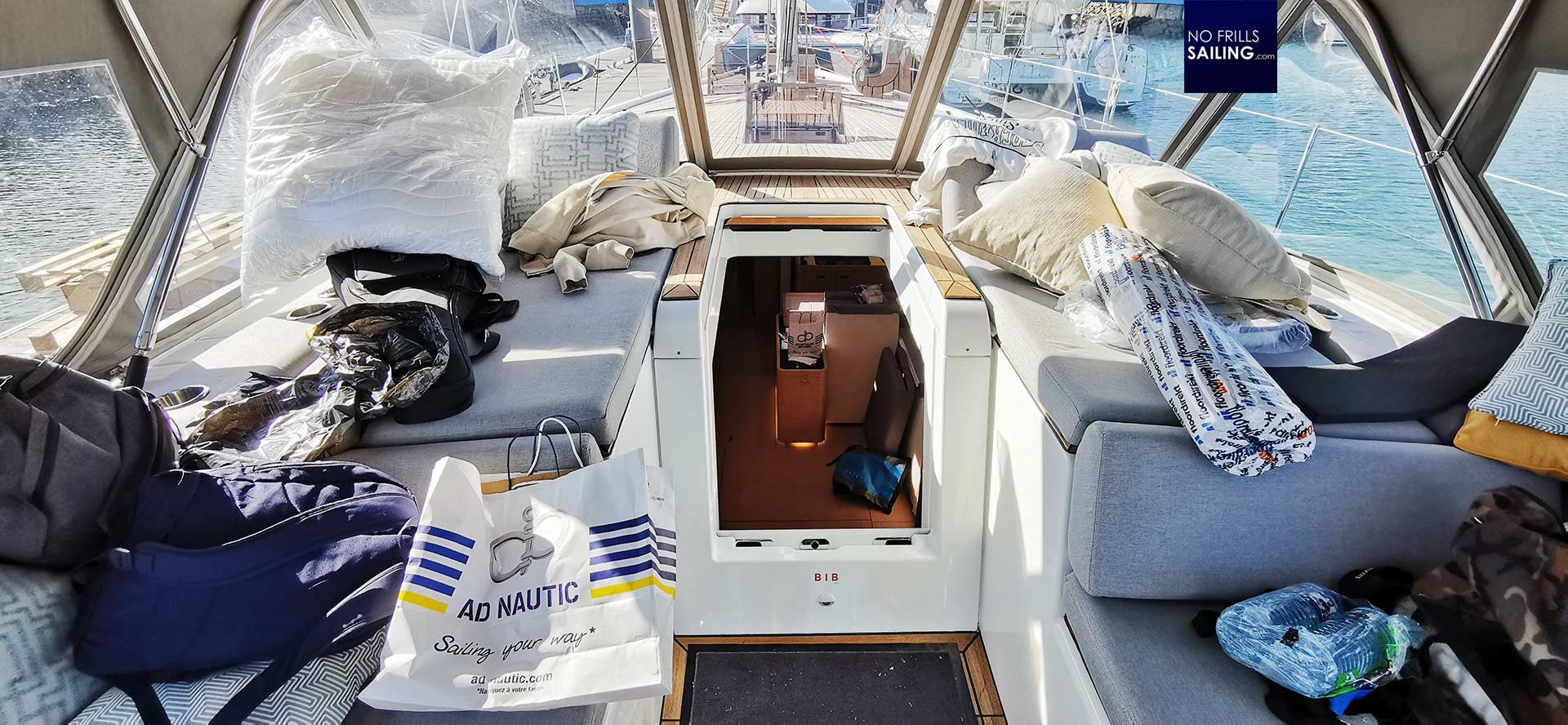
The problem ist hat you need a system. If not, you are unpacking stuff on the one side and mess up the other side with empty cardboard boxes, plastic and Styrofoam. This clearly is the domain of the female part of the owner. Lady Captain is traditionally the one who has the taste and the oversight to tackle such a huge project. Luckily, they have two of their children (grown up youngsters) with them so that it does not lack of strong helping hands. Nevertheless, the whole yacht turns into a mess in a matter of minutes. A stage she will remain in for hours before everything is unpacked and put to its designated location.
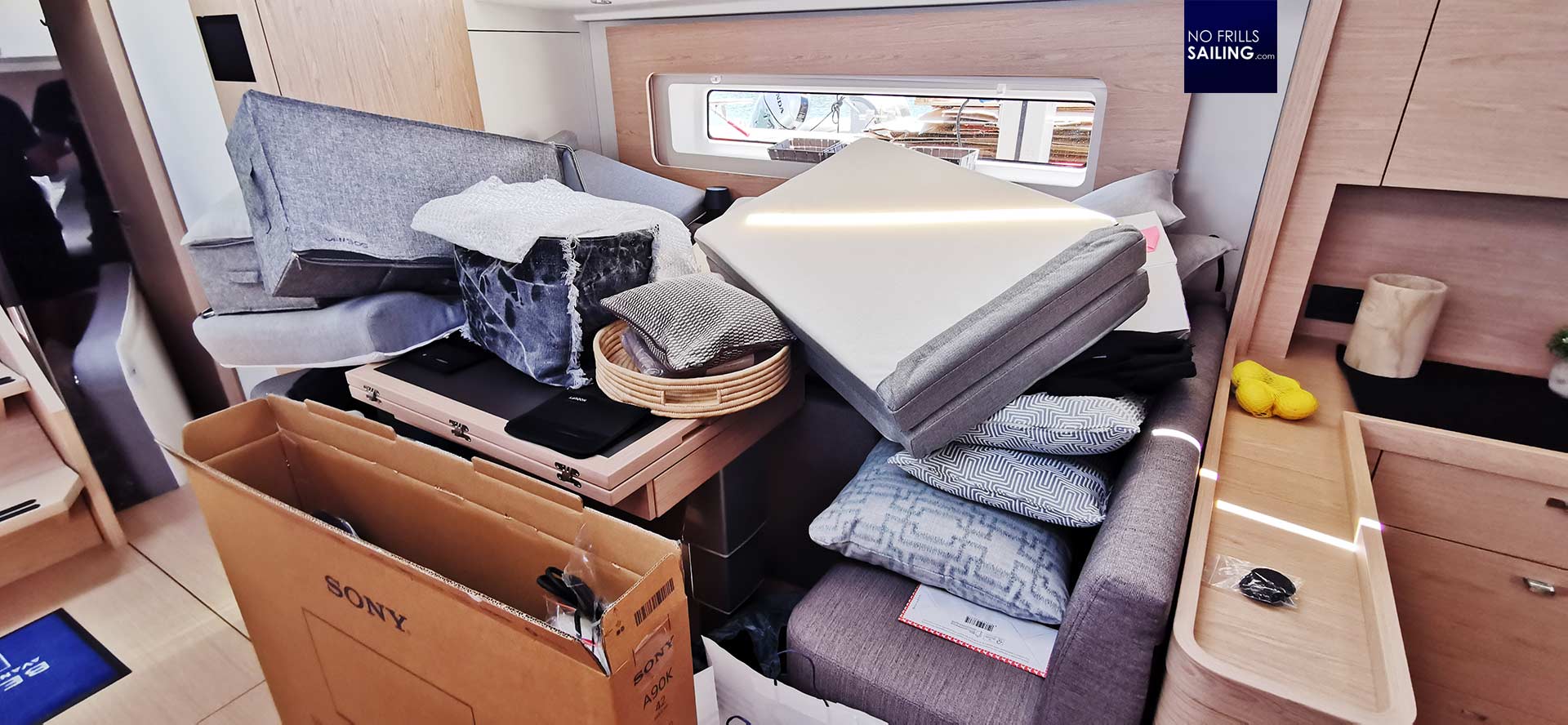
You may have read my article about the “biggest puzzle on board” a big boat? It´s the cushions. On a yacht like the Oceanis Yacht 60 there are more than a dozen big sized cushions. They look so super cozy (and they are!) when put outside to their designated locations – but they fill up (literally!) one full aft cabin when taken off. In case of rain for example. This is a learning for my own new boat: As much as I love this custom fit cushions in the cockpit, I will refrain from making those for my Omega 42. I will have cushions, but they will be small and little and nicely space-saving.
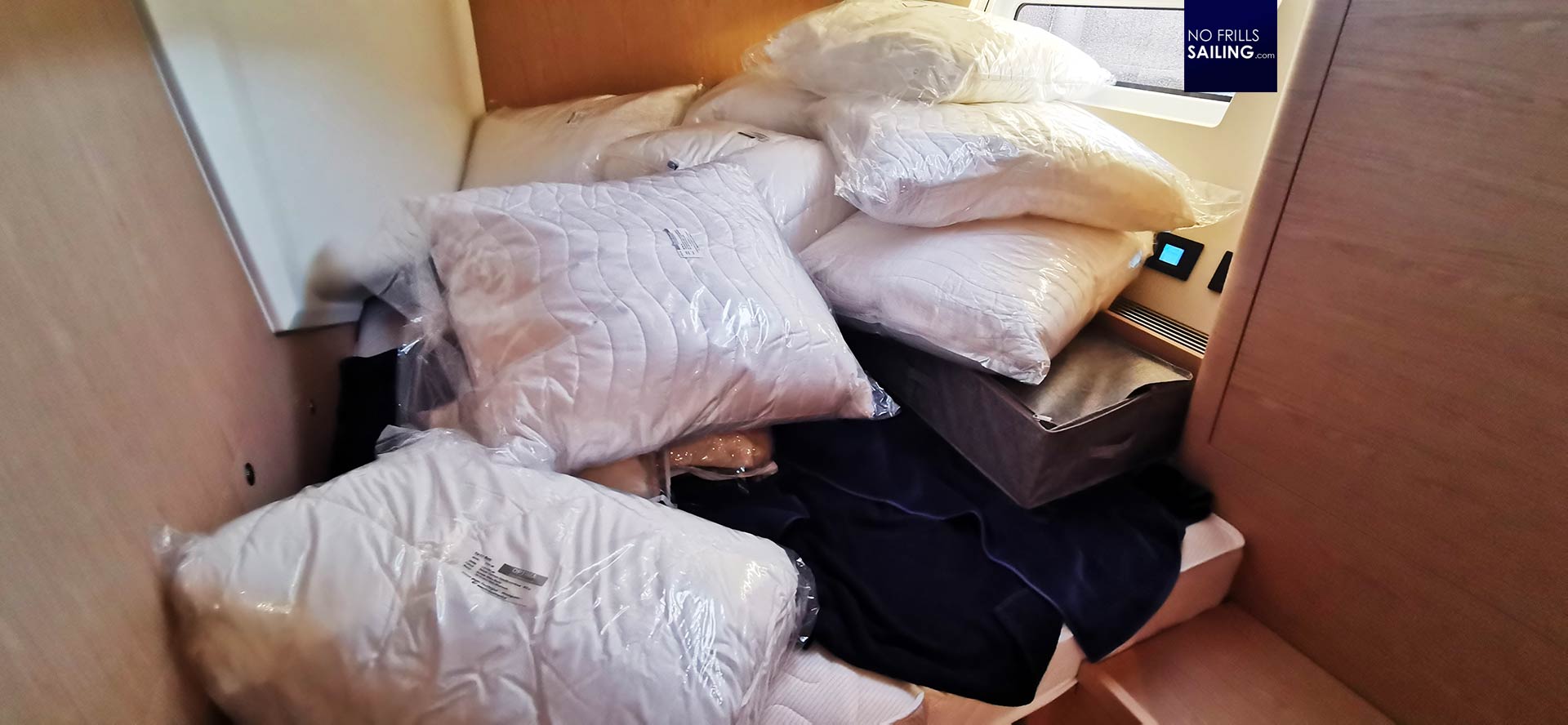
It takes full two hours to get the cabins ready. Boat mattrasses, of course, usually don´t have standard sizes. Especially the front cabin mattrasses come in really nice shapes, which makes it almost inevitable to get custom-tailored bed linen. In case of SOSIMA, our owners did get the measurements of each cabin´s beds and had produced custom fitting duvet covers and bed sheets. Of course, blankets and pillows are standard size, but they also went for custom bed linen with ship´s name embroided. Nice.
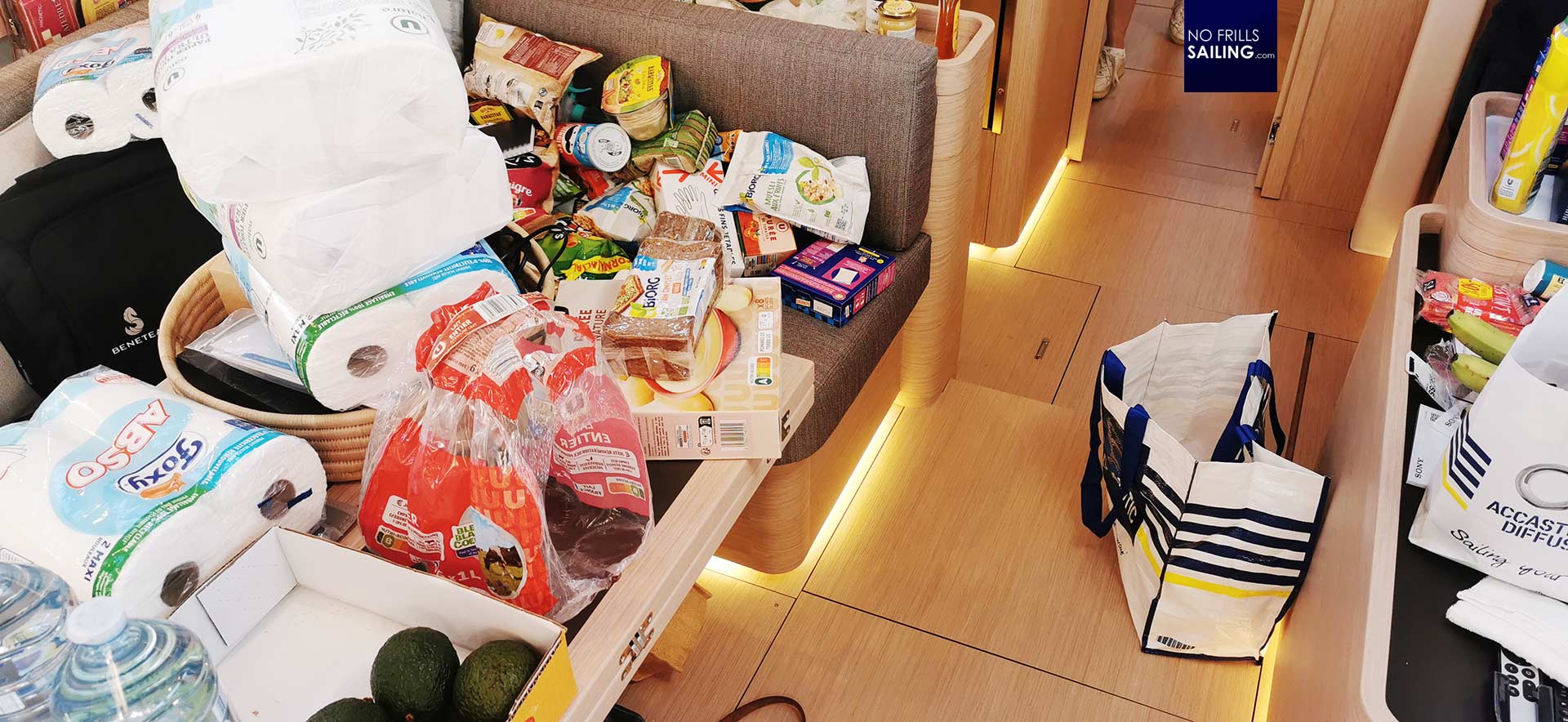
The sun is about to go down and even if French supermarkets are open very long, closing time is approaching. We have a tight schedule for the shakedown cruise and there is currently a nice weather window in the Bay of Biscay ensuring a smooth passage, so that it is a bit of a hurry to buy the provisions for the long first sailing trip. Having cleaned up the mess just an hour before, SOSIMA returns to a hodgepodge-state after the guys arrive back from the Supermarché.
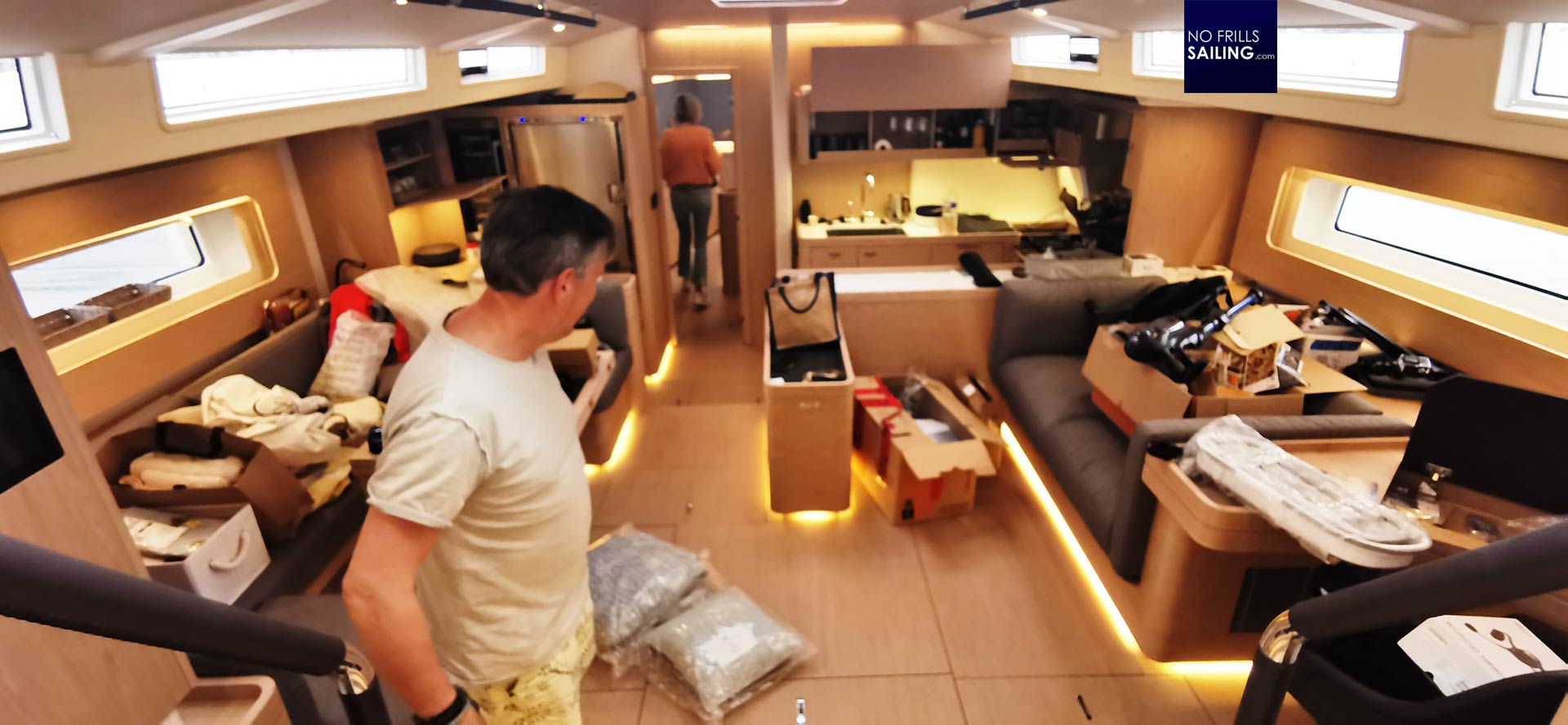
Night falls and there´s still so much to do. We are all tired and a bit worn down after the past intense three handover days. Frequently checking the weather apps for updates, a sense of pressure is building up amongst the crew: We all want to leave now for good, at last taking on the big first journey. Where to put the eggs? Where have you stored the life belts? Who has seen the curtesy flags for the last time? And where the hell are my sailing shoes? We work in a hurry to get SOSIMA ready for casting off.
A special concern …
… or service of my company, you may call it. It´s as well surely a deeply personal concern of myself as the boat dealer and a sailor, to accompany my clients and freshly baked owners on their first sailing trip. This is not just “around the corner”, as it is the case with many of our clients. SOSIMA will be based in the Mediterranean – sailing her all across the notorious Bay of Biscay, along the perilous Spanish-Portuguese Atlantic coast, through the Gibraltar strait and up north to Valencia is indeed a huge undertaking for a freshly baked crew owning such a big boat. I offered to be with them at least for the Biscay until Porto or Lisbon.
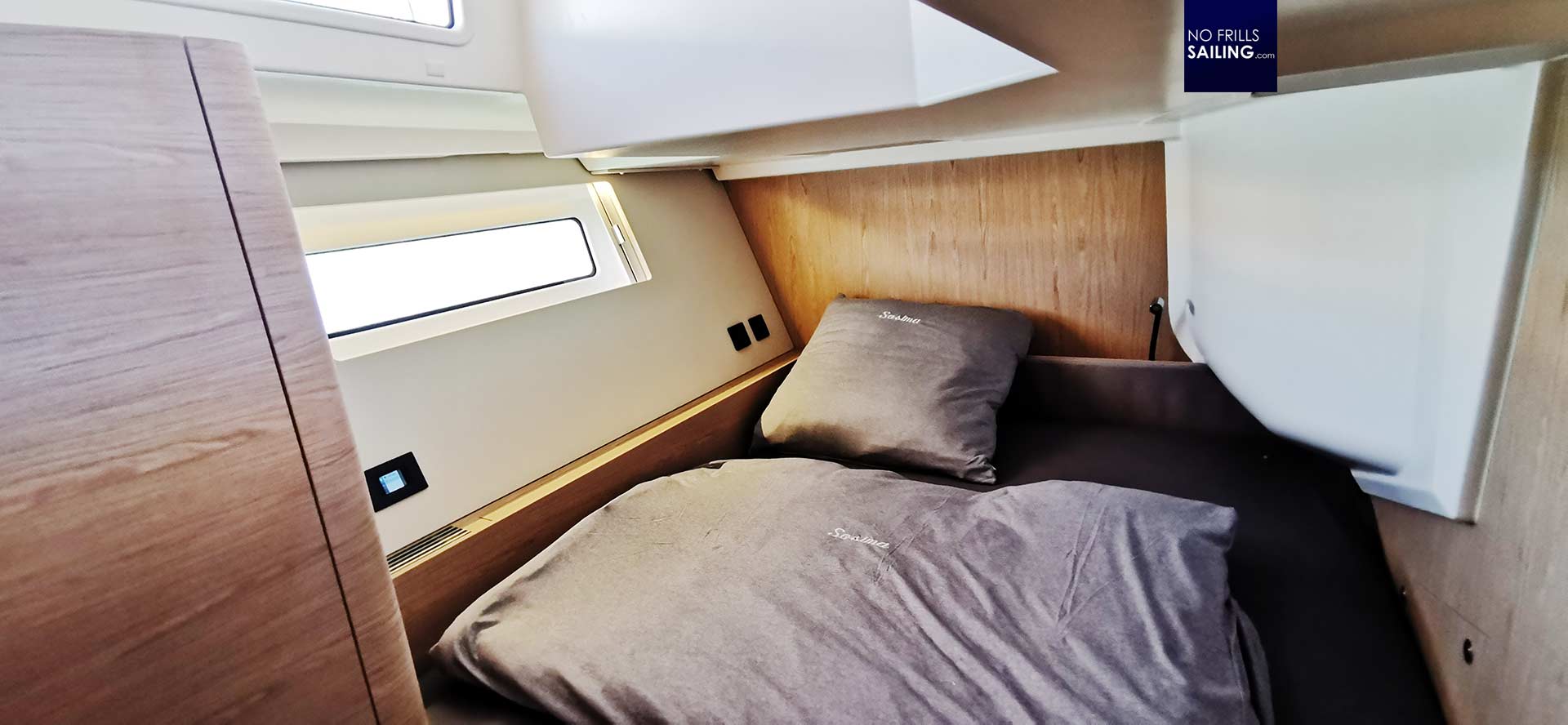
An offer they gladly accepted, as it is done by most of my clients. Having your boat dealer on board opens up some nice opportunities: First it adds a sense of safety or security to the new owners, also since I´ve done the Biscay a couple of times before. It also is kind of re-assuring as I can be referred to as their “living handbook” and I can take care of the first issues if detected. As for SOSIMA, having a second skilled sailor aboard means that we can safely sail through the night as the owner and I will run two shifts á 4 hours each. Apart from that, it´s a huge chance for me to really sail this yacht under real conditions, to learn, to absorb, to become more and more familiar with this boat, which in turn will help me sell more of those, of course.
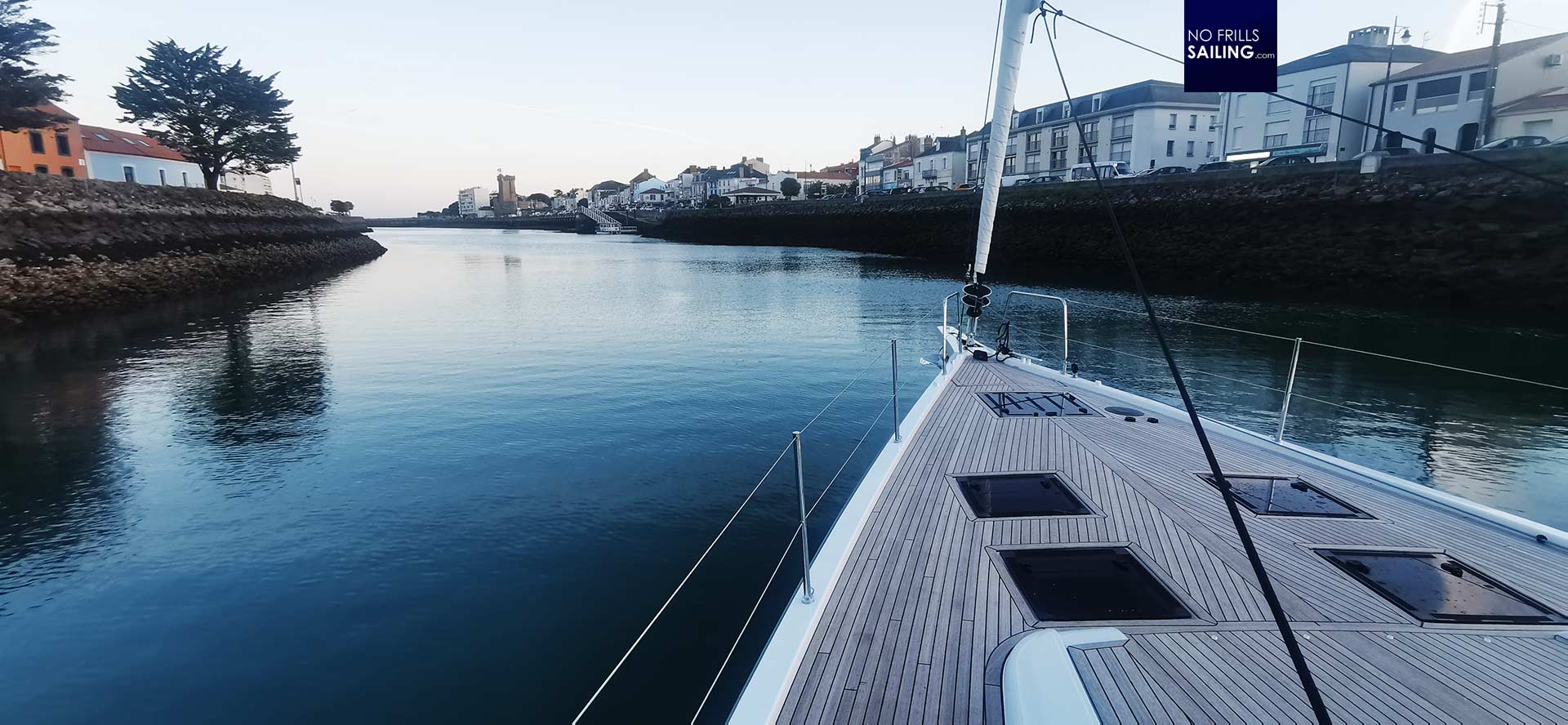
Everything is done. Everything is right. All is stowed away, tanks are filled to the brim. We are geared up, lines taken in. SOSIMA casts off. Steaming steadily down Les Sables harbor, facing the breakwater harbor lights, we sail into the darkening Atlantic Ocean. A low but steady 10 knots wind is blowing. Getting out the sails in a matter of seconds, we decide to steer due 250 degrees as we expect a wind shift tomorrow. A final looking back onto Les Sables, then we´re off. Handover completed – maiden voyage ahead!
Related articles which you may also find interesting to read:
Part 1 of Big Boat Handover
The Oceanis Yacht 60 moulds in the shipyard at Beneteau
Smooth and fast – sailing the Oceanis Yacht 60
